Materuni Waterfall is one of the most breathtaking yet underrated experiences in Tanzania — and it’s surprisingly easy to visit.
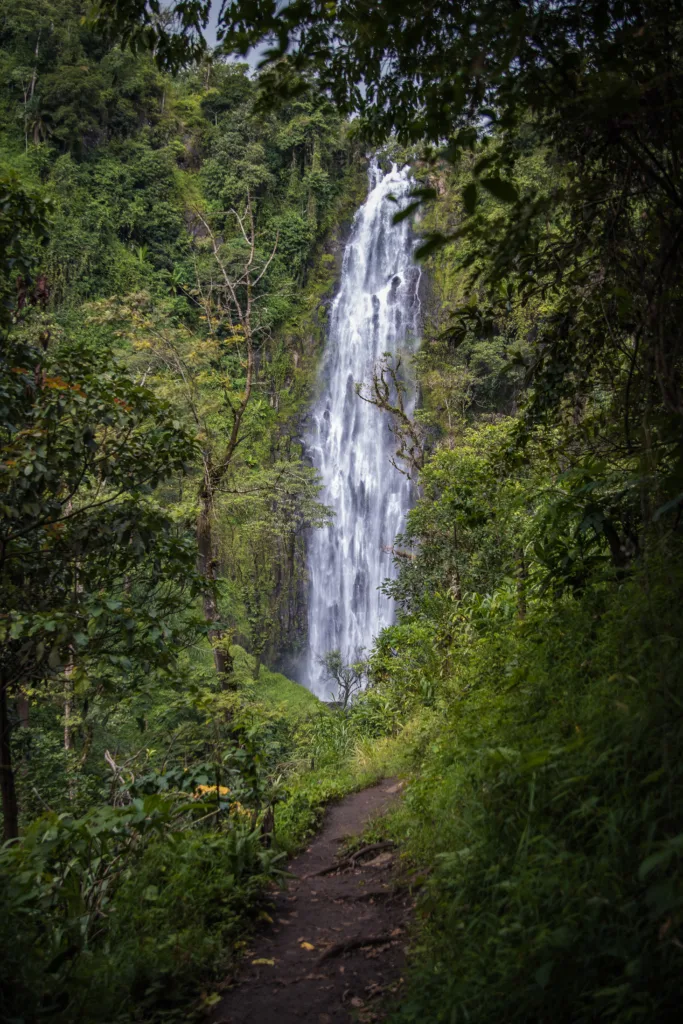
Nestled in the lush Kilimanjaro foothills, this glacier-fed waterfall tumbles over 70 meters into a natural pool, surrounded by thick rainforest and banana groves.
Just 45 minutes from Moshi, it makes for a perfect half- or full-day trip that blends nature, culture, and local flavors in one unforgettable adventure.
If you’re looking for a Moshi day trip that includes hiking, swimming, a local coffee tour, and lunch with the Chagga tribe, Materuni has it all.
In this post, you'll find...
Toggle✅ Quick Summary: Why Visit Materuni Waterfall?
| Feature | Why It’s Special |
|---|---|
| Height | 70–80 meters – one of Kilimanjaro’s tallest waterfalls |
| Hiking time | 45–60 minutes through rainforest and banana plantations |
| Bonus | Traditional Chagga coffee tour & homemade banana beer |
| Swim | Cold, glacier-fed pool – refreshing and scenic |
| Accessibility | Easy day trip from Moshi – no 4×4 required |
My Experience at Materuni
When I visited Materuni village, I wasn’t expecting to be so blown away. I thought it would be “just another waterfall,” but it turned into one of my favorite memories from northern Tanzania.
The Materuni hike was peaceful and scenic — not too strenuous, but enough to feel like a mini adventure. Our local guide, Daniel, grew up in the area and pointed out everything from medicinal plants to monkey tracks along the trail.
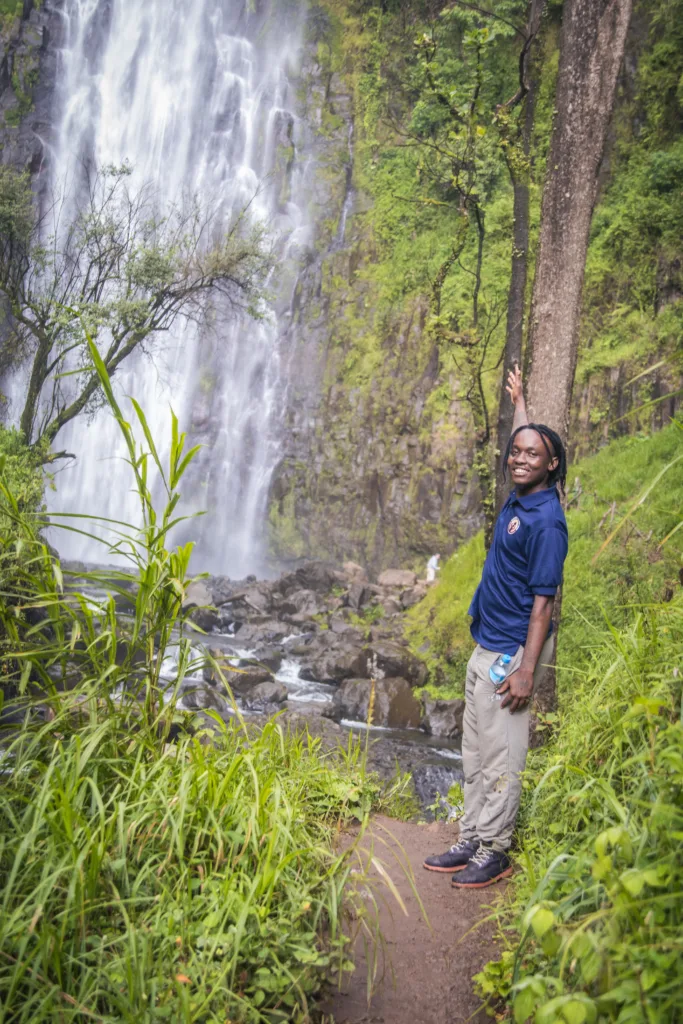
I loved how it wasn’t rushed; he genuinely wanted us to understand his home.
The sound of the waterfall grew louder with each step until we reached a clearing — and there it was. Towering, wild, and pouring into a shimmering pool that looked almost fake. I didn’t plan on swimming, but the sun was hot and the temptation won.
I jumped in fully clothed — and it was freezing — but worth it.
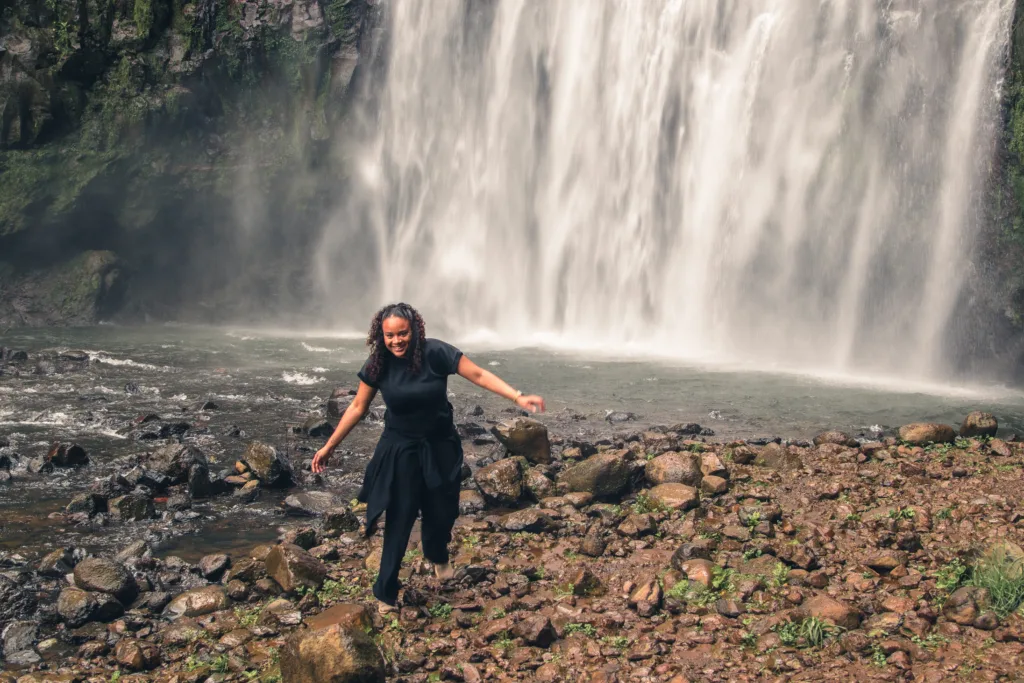
After drying off, we returned to the village for the Materuni coffee tour.
We roasted fresh beans over an open fire, ground them with a mortar and pestle, and sipped the most delicious Materuni waterfalls mocha I’ve ever had. I still dream about it.
We laughed with the locals, learned about coffee roasting traditions, and even danced a little. This wasn’t just a hike — it was a connection to nature, culture, and people.
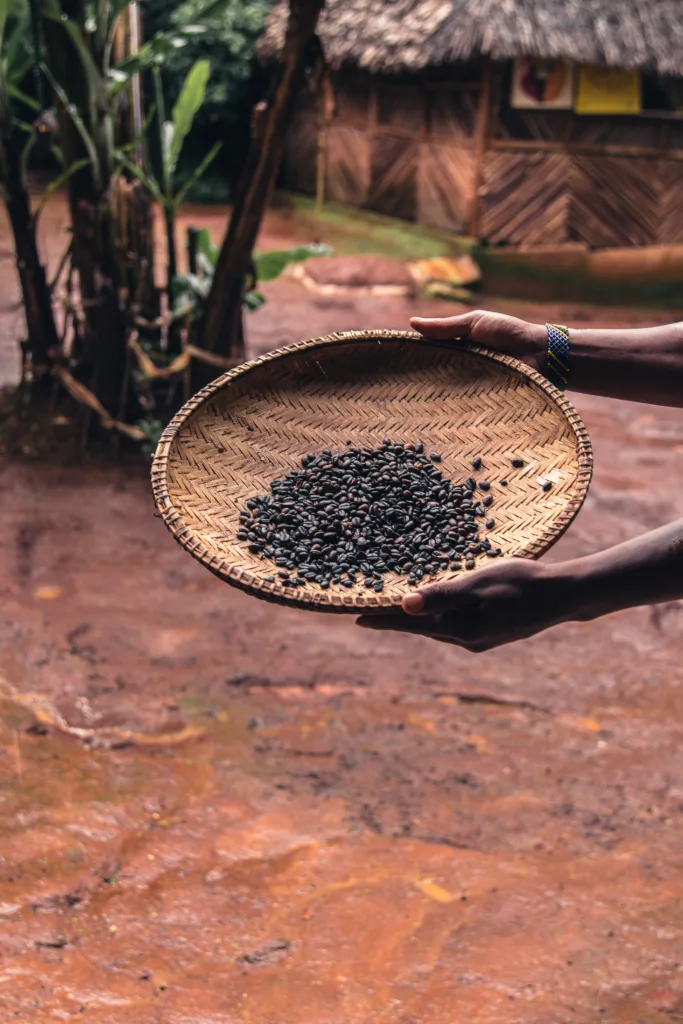
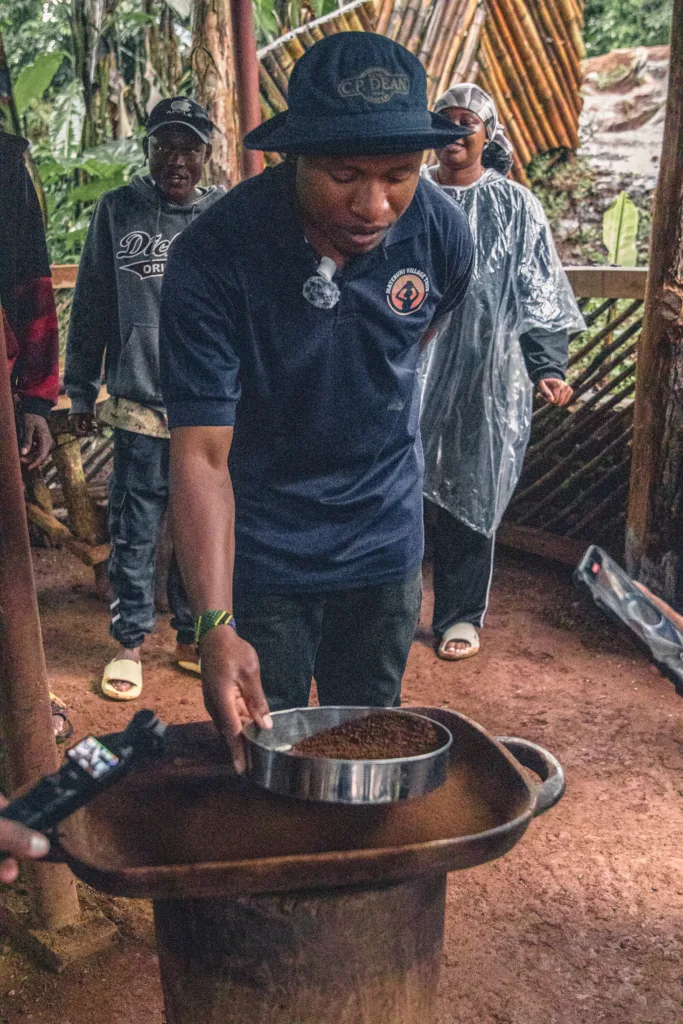
✍️ What Makes Materuni Special?
- Authenticity: You’re not just hiking to a waterfall — you’re stepping into a real village with real stories.
- Accessibility: You don’t need a 4×4 or a long travel day. Materuni is close enough for a spontaneous trip but far enough to feel remote.
- Variety: It’s more than just the falls. The full experience includes a coffee tour, lunch, and cultural exchange.
📍 Where is Materuni Waterfall Located?
Materuni Waterfall is located in Materuni village, a small community in northern Tanzania at the base of Mount Kilimanjaro, just 15–20 kilometers from Moshi town.
It sits in the verdant Kilimanjaro foothills, at an altitude of around 1,800 meters, making the area cooler, greener, and more peaceful than the lowland towns.
Fast Facts
- 📌 Location: Materuni Village, Kilimanjaro Region, Tanzania
- 🚗 Distance from Moshi: ~45-minute drive
- 🥾 Hike starts at: Materuni village gate (~1,800m elevation)
🌱 What’s So Special About the Location?
The setting is what makes Materuni Waterfall unique. Unlike many popular tourist stops, this one is embedded in a living, breathing village—not fenced off or commercialized. The area is home to the Chagga tribe, who have lived on the slopes of Kilimanjaro for generations, farming bananas and coffee in harmony with the land.
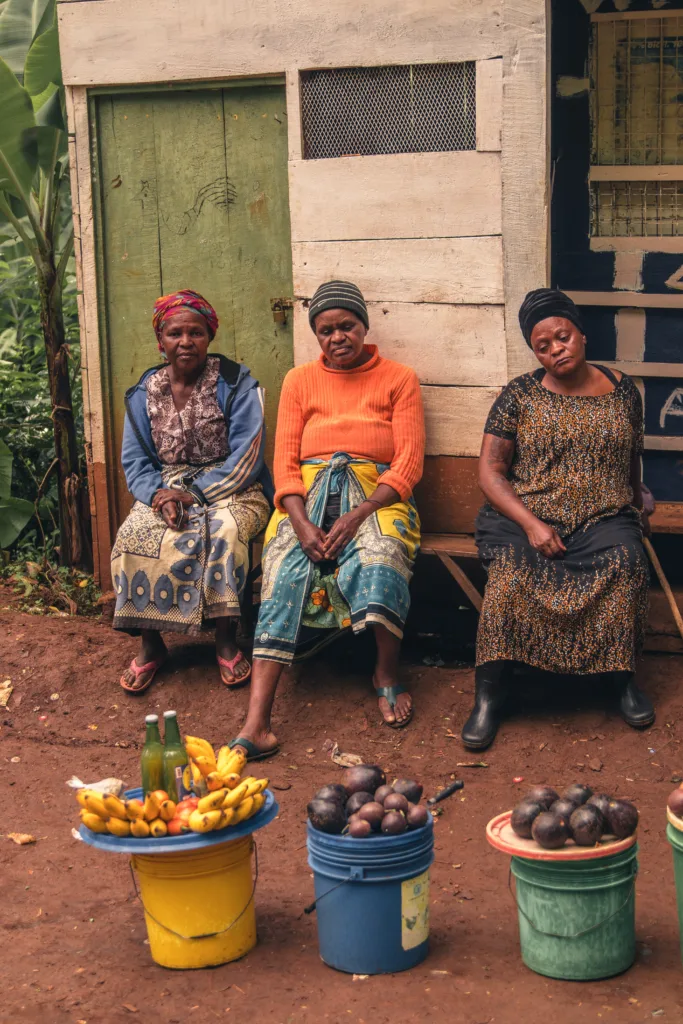
As you drive in, you’ll pass lush banana farms, handmade brick homes, and kids waving from the roadside. It’s rural, authentic, and photogenic in the best way.
🚘 How to Get There from Moshi
There are three main options:
- Book a guided tour from Moshi(Most popular)
- Many tour companies include Materuni hike + coffee tour in one package.
- Some offer add-ons like Kikuletwa Hot Springs (Chemka Hot Springs) in the afternoon.
- Hire a private driver (if you want more flexibility)
- You’ll still need to pay local entry fees and hire a local guide at the village.
- Public transport + hike (budget option)
- You can take a dala-dala (minibus) to Uru or Shanty Town and walk/hitch from there, but it’s not easy unless you’re familiar with the area.
🔑 Tip: If you want a stress-free day, go with a local tour operator. It usually includes transport, guide, lunch, and coffee tour.
🗺️ Map Coordinates (For DIY Travelers)
You can plug this into Google Maps:
📍 Materuni Waterfall: -3.265985, 37.355895
But be warned—roads can be rough near the end, especially in the rainy season. If you’re self-driving, a 4×4 is helpful.
What to Expect on the Materuni Hike
The Materuni hike is a 45–60 minute guided trail through rainforest and banana farms, ending at a 70–80 meter glacier-fed waterfall. It’s moderately easy and best done with a local guide.
The Materuni hike is a refreshing blend of light adventure and cultural immersion — perfect for beginner to moderate hikers.
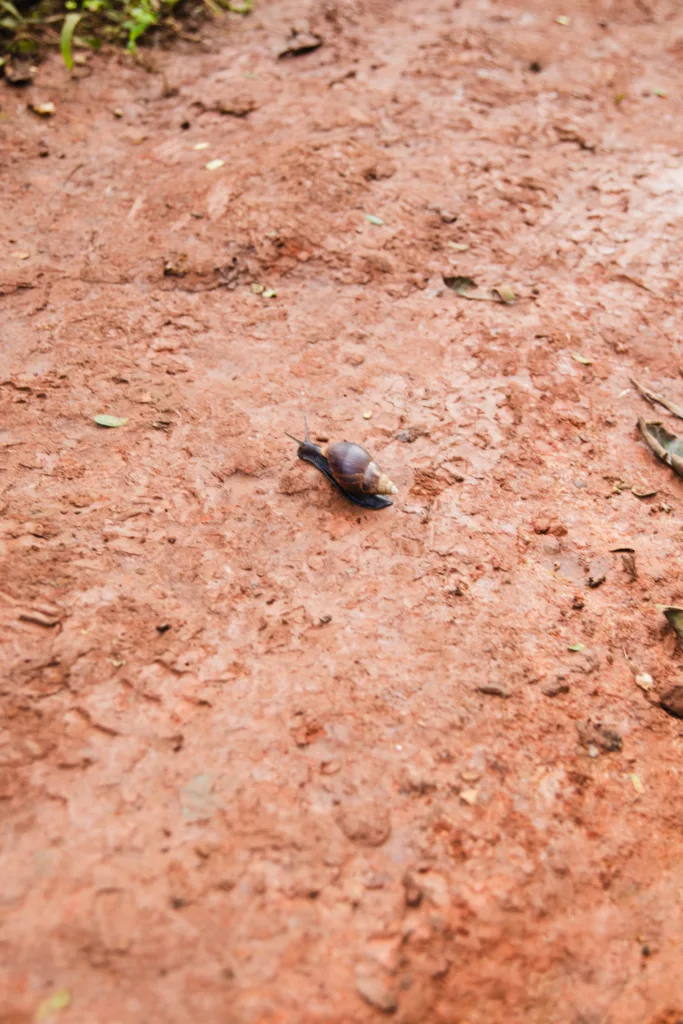
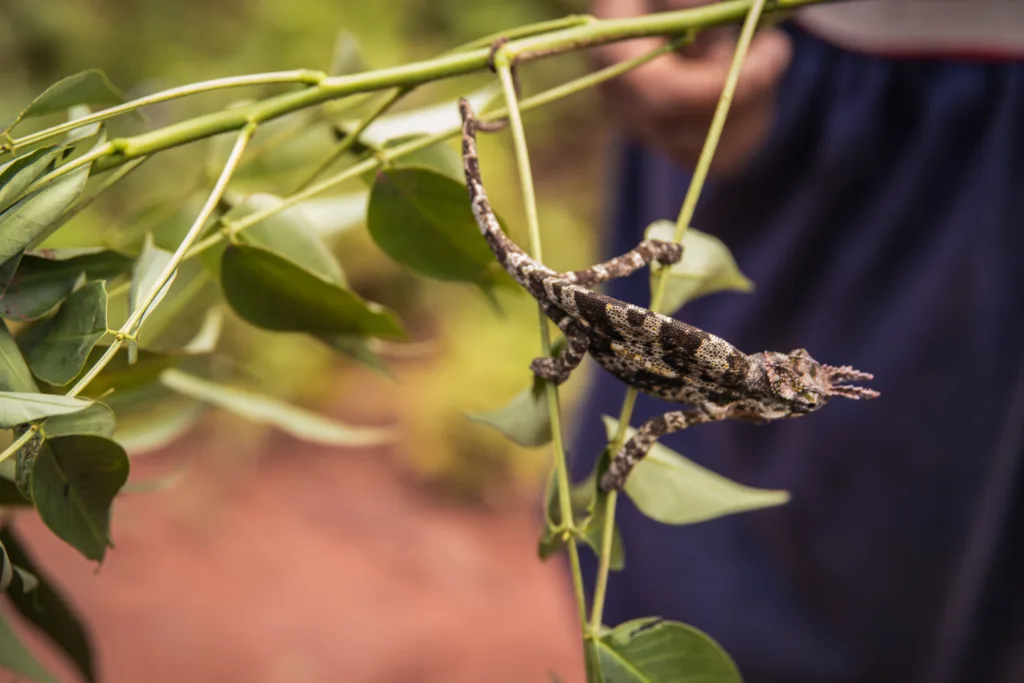
It’s short enough for a relaxed morning or afternoon but rich in natural beauty, with scenic views, bird calls echoing through the trees, and the chance to learn about local life from a Chagga guide who actually grew up in the area.
🗺️ Trail Overview
- Length: ~1.5–2 km each way (depends on starting point)
- Duration: 45–60 minutes total walking time
- Elevation: ~1,800 meters (cool, but not high-altitude hiking)
- Difficulty: Easy to moderate
- Trail Conditions: Dirt path with some uneven or muddy sections during the wet season
It starts just outside Materuni village, often after a short cultural introduction. You’ll pass banana plantations, small coffee farms, and streams that cut through thick greenery.
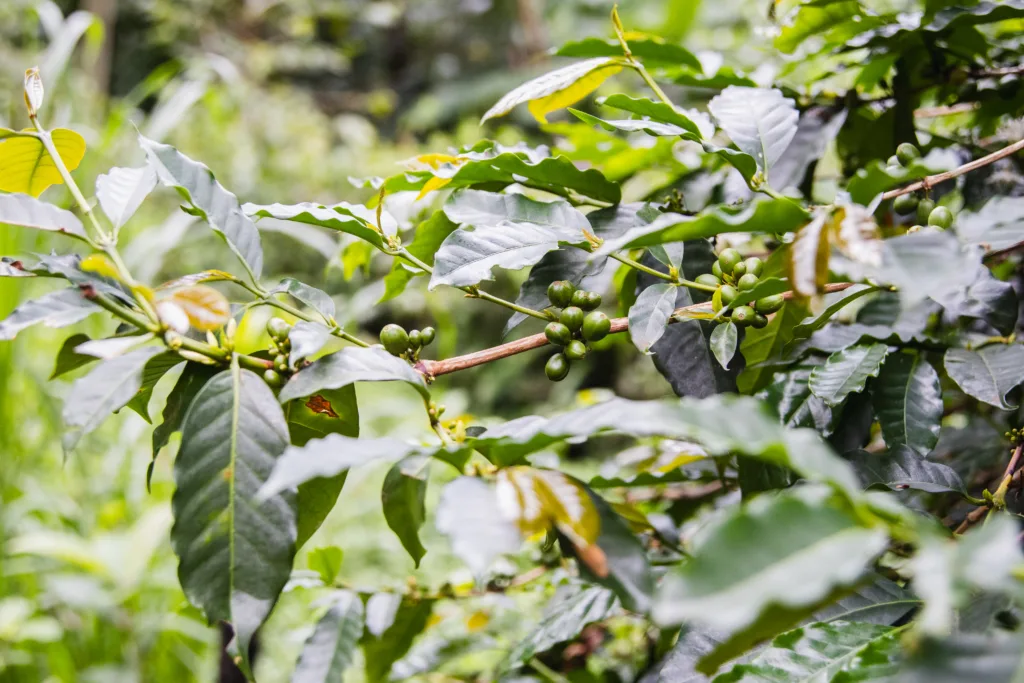
Along the way, your local guide will point out everything from edible plants to traditional irrigation systems.
🌿 What You’ll See Along the Trail
✅ Thick rainforest canopy
✅ Rows of banana trees and coffee bushes
✅ Local homes and small farms
✅ Medicinal plants and flowers
✅ Birds, butterflies, and (sometimes) monkeys
✅ Occasional peeks of Mount Kilimanjaro (if the clouds clear)
One of my favorite moments was when our guide picked a wild guava and sliced it for us to try. Simple, but memorable. It felt more like walking with a friend than a formal “tour.”
❄️ Ending at the Glacier-Fed Materuni Falls
The hike ends dramatically at Materuni Waterfall — a 70–80 meter tall, thundering cascade that pours from the mountains above.
It’s glacier-fed, meaning the water is icy cold year-round — a fact I learned the hard way when I jumped in. (Spoiler: totally worth it.)
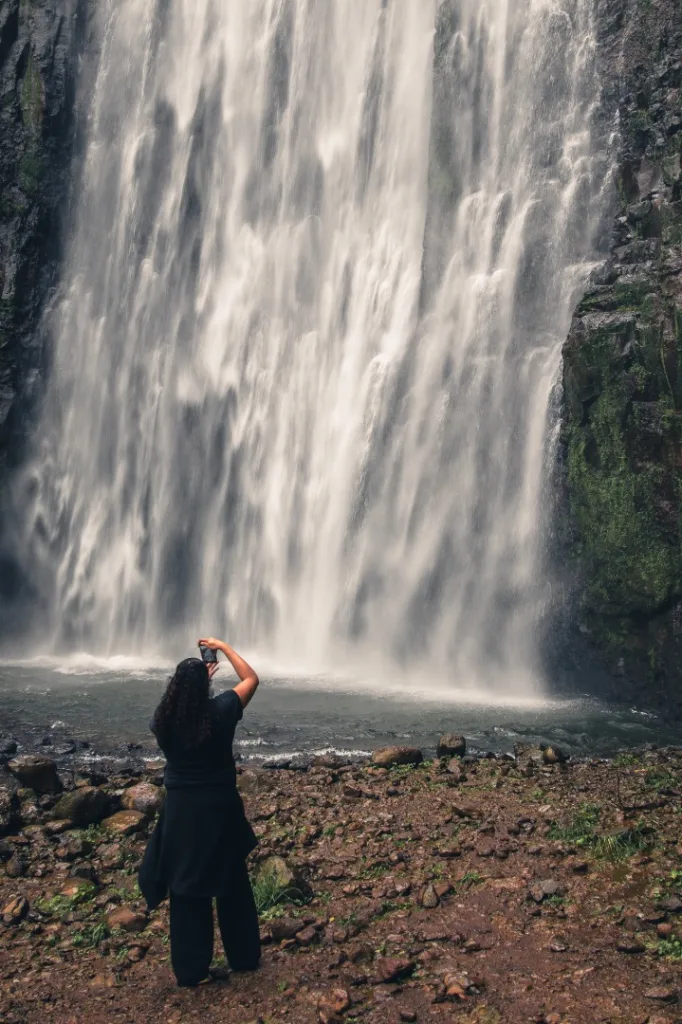
💧 Can You Swim at Materuni Waterfall?
Yes, swimming is allowed — and encouraged! There’s a clear pool at the base of the falls. It’s cold, rocky, and powerful, so use caution and bring a towel.
🥾 Pros & Cons of the Hike
| Pros | Cons |
|---|---|
| Scenic and culturally rich | Muddy in rainy season (bring boots!) |
| Short enough for non-hikers | Can be slippery near the waterfall |
| Guided by friendly locals | Not wheelchair accessible |
| Includes a unique coffee tour | Insects are common — pack bug spray |
🔑 Pro Tip: Bring water, wear proper shoes (not flip-flops), and pack a rain jacket — even in dry season, the falls create mist and the rainforest stays damp.
🎒 Packing Checklist for the Hike
- Sturdy walking shoes or hiking boots
- Water bottle
- Rain jacket or poncho
- Towel + swimsuit (for waterfall swimming)
- Cash (for tipping your local guide or buying coffee)
- Camera or phone (you’ll want photos)
☕ The Coffee Experience in Materuni Village
One of the absolute highlights of visiting Materuni Waterfall isn’t the waterfall at all — it’s the coffee tour that follows.
After your hike and (maybe) a chilly swim, you’ll return to Materuni village, where local Chagga hosts take you through the traditional process of coffee roasting, grinding, and brewing — all by hand, all outdoors, and all while singing, laughing, and sharing.
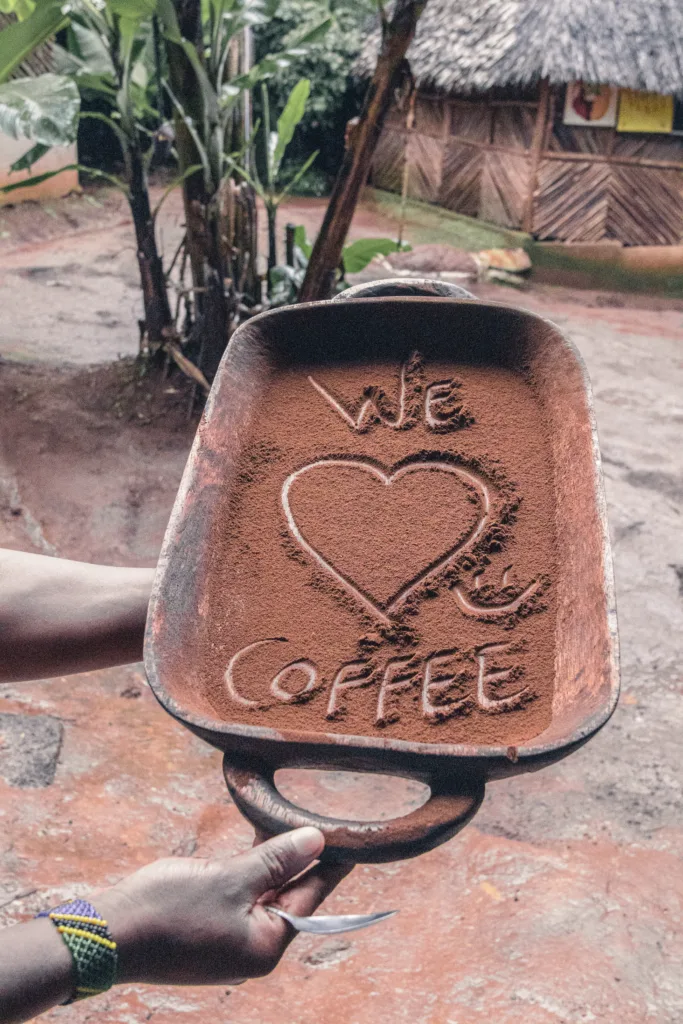
The Materuni coffee tour is a hands-on cultural experience where visitors roast, grind, and brew Arabica beans grown in the Kilimanjaro region with the help of local Chagga hosts. It includes tastings, dancing, and often banana beer.
🌱 From Bean to Cup: What You’ll Learn
The Materuni coffee tour isn’t just a demonstration — it’s participation. You’ll learn how coffee is made, from fresh red cherries to your steaming cup.
Here’s how the experience unfolds:
1. Harvesting (seasonal)
Depending on the time of year, you may help pick ripe coffee cherries from bushes grown right in Materuni village.
2. Pulping
You’ll remove the outer skin by hand — usually by crushing them in a wooden pestle.
3. Fermenting and Washing
Locals explain how the beans are fermented, dried, and washed using natural methods — no machines here.
4. Roasting
Beans are roasted over a fire in a large pan. This is the part where everyone gets involved, singing and clapping to keep rhythm while stirring. It smells incredible.
5. Grinding
You’ll grind the roasted beans with a giant wooden mortar and pestle. This step is also accompanied by singing and drumming — everyone joins in!
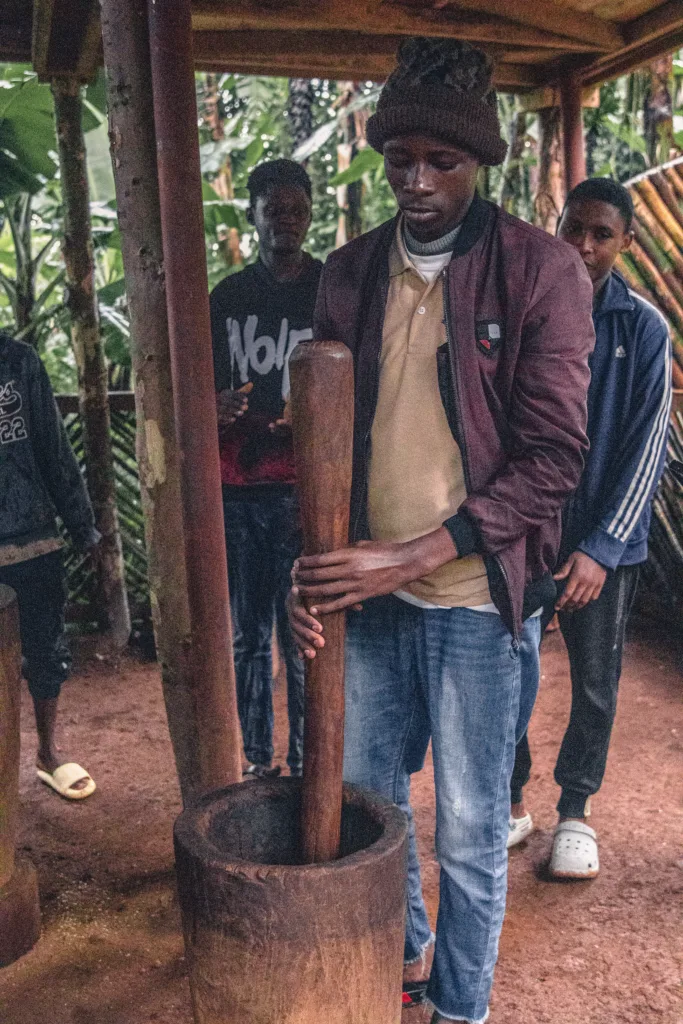
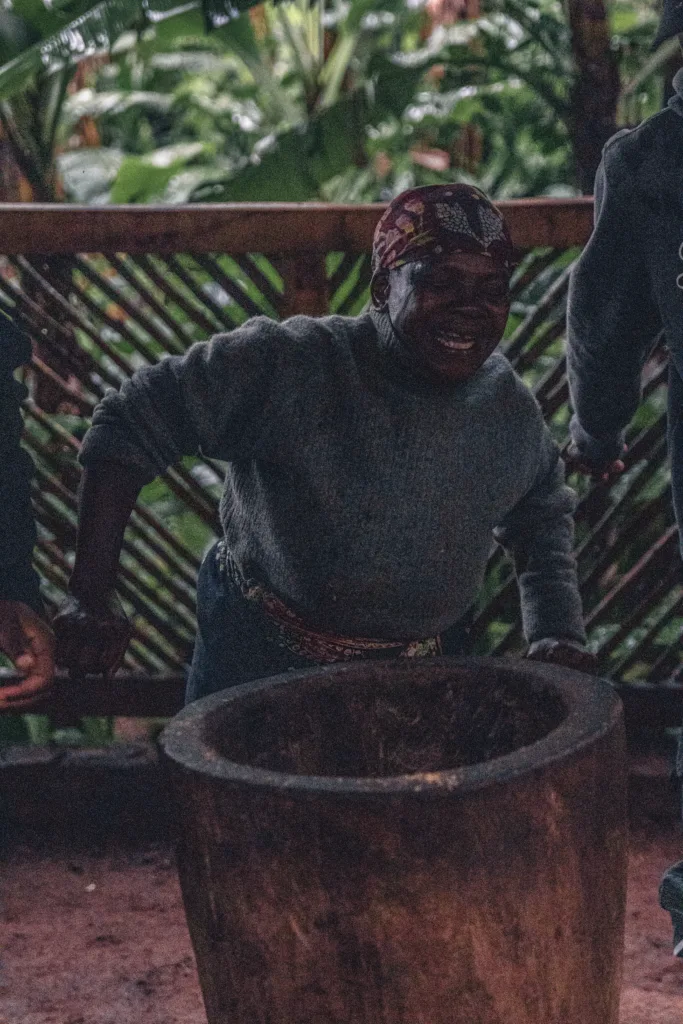
6. Brewing
The freshly ground coffee is brewed in a pot and poured into mugs. You can drink it black or sweetened — no milk, just sugar.
☕ The Flavor: Why Materuni Coffee Tastes So Good
Because the beans are grown in rich volcanic soil, in the cool Kilimanjaro foothills, and processed traditionally, the coffee is incredibly fresh and smooth. Some call it Materuni waterfalls mocha (not because it has chocolate, but because of how rich it tastes).
If you’re a coffee lover, it’s a dream. If you’re not a coffee drinker, you’ll still probably love it — it’s that good.
🪘 More Than Coffee: Chagga Hospitality & Banana Beer
This isn’t a formal “tour.” It’s more like being invited to hang out with the community. Along the way, your hosts will teach you about Chagga tribe history, local farming practices, and daily life in Materuni village.
You may also be offered a taste of banana beer — a local fermented drink made from ripe bananas and sorghum. It’s an acquired taste, but worth trying!
💬 My Favorite Part
During my coffee tour, we danced around the fire while roasting the beans, laughing as someone added too much heat and almost burned them. When the coffee was ready, they handed me a handmade mug and said, “Karibu!” (Welcome.) It tasted smoky, earthy, and bold — and drinking it in the cool mountain air made it unforgettable.
I ended up buying a bag of roasted beans to take home — and I wish I had bought more.
🍛 Traditional Tanzanian Lunch in Materuni Village
After the Materuni hike and coffee experience, you’ll be more than ready for a good meal — and the traditional Tanzanian lunch served in Materuni village does not disappoint.
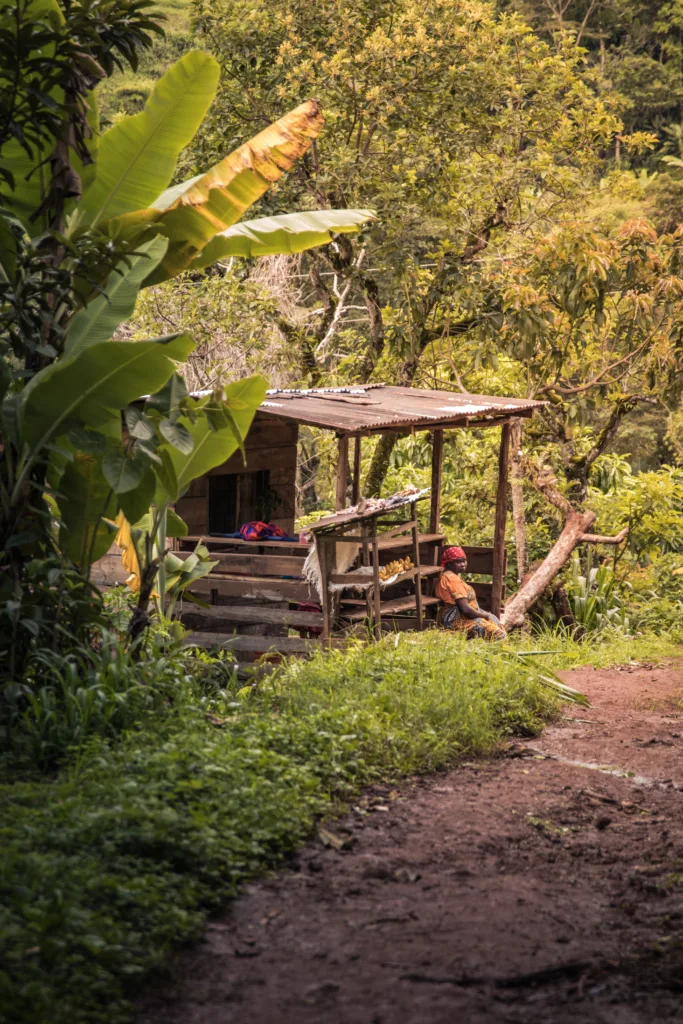
It’s simple, hearty, and home-cooked by local women using regional ingredients and age-old Chagga tribe recipes.
Lunch in Materuni typically includes rice or ugali, banana stew, local vegetables, and sometimes beef or beans, all prepared fresh in the village. Meals are included in most guided tours.
🍽️ What’s on the Menu?
Every lunch varies slightly depending on what’s in season, but here’s what you can typically expect:
- Rice or Ugali – Uganda’s famous maize flour dough, perfect for scooping
- Ndizi – Banana stew (sweet or savory, sometimes with meat)
- Mchicha – Cooked greens, similar to spinach
- Red beans – Slow-cooked and full of flavor
- Cabbage stew – Lightly spiced and often cooked with carrots
- Fruit – Fresh papaya, pineapple, or watermelon
- Optional meat – Sometimes beef stew is included
The meal is served on large shared platters, and you’ll eat with your hands if you want to go full local (though utensils are available).
🪴 What Makes It Special
- It’s home-cooked. The food isn’t made for tourists — it’s made with care, the way it’s always been prepared in the village.
- It’s included. Most Materuni waterfall tours include lunch in the price.
- It supports local families. The women preparing your food are often from the same families who guide the tours or run the coffee experience.
- It’s a cultural experience. Mealtime is communal, and it’s a great chance to sit, chat, and connect with locals.
💡 Pro Tip: Vegetarian? Just ask ahead. The standard dishes are naturally meat-free, but a heads-up helps your hosts prepare accordingly.
💬 A Personal Note
I still remember sitting on a wooden bench in the sun, drinking fresh coffee and eating banana stew with a group of strangers who felt like friends by the end of the day. There were no menus, no time limits — just warm food, kind people, and a view of the green valley below. It was the kind of slow, intentional travel moment that sticks with you.
✅ Key Takeaways
- A traditional lunch in Materuni is part of most full-day tours.
- Meals are home-cooked, fresh, and often vegetarian-friendly.
- Dishes feature local staples like bananas, beans, ugali, and seasonal fruit.
- Eating in the village supports the community and enhances the cultural experience.
- Don’t forget to bring a tip or small gift — it’s always appreciated.
💦 Optional Add-On: Kikuletwa (Chemka) Hot Springs
If you want to turn your Materuni Waterfall day trip into a full-day adventure, consider adding a visit to the nearby Kikuletwa Hot Springs, also known as Chemka Hot Springs. These natural thermal pools are one of northern Tanzania’s hidden gems — warm, clear, and surrounded by twisting fig trees and palm groves that make it feel like a secret jungle oasis.
Chemka Hot Springs is a geothermal swimming hole located 1–1.5 hours from Moshi. It’s often included as a combo trip with Materuni Waterfall, perfect for relaxing after a morning hike.
📍 What & Where Is Chemka?
- Location: ~1–1.5 hours from Moshi (in the opposite direction of Materuni)
- Temperature: ~27°C (80°F) — naturally heated by underground volcanic activity
- Depth: Varies — shallow entry areas plus a deep swimming hole with a rope swing
- Nickname: “The Blue Lagoon of Tanzania” for its crystal-clear water
Despite the name “hot springs,” the water is more warm and soothing than truly hot — perfect for cooling off after hiking to Materuni falls.
🏖️ What to Expect
- Clear, turquoise water (you can see straight to the bottom)
- Rope swings, tire tubes, and shaded areas for relaxing
- Small vendors selling snacks, drinks, and local food
- Optional massage services and picnic spots
While Materuni waterfall is an adventure in nature and culture, Kikuletwa is the place to relax. It’s great for groups, solo travelers, or families — and the vibe is fun and social, especially on weekends.
🕒 Combo tours usually start at Materuni in the morning, then head to Chemka in the afternoon for a swim and sunset.
🚌 How to Get There
- Tour package (recommended): Many operators in Moshi offer a combined Materuni + Chemka Hot Springs trip with lunch, guides, and transport.
- Private driver: Good if you want flexibility but can get pricey for solo travelers.
- Self-drive: Roads to Chemka are rough — 4×4 recommended.
🌤️ Best Time to Visit Materuni Waterfall
One of the best things about Materuni Waterfall is that it’s beautiful year-round — but your experience can vary greatly depending on the weather.
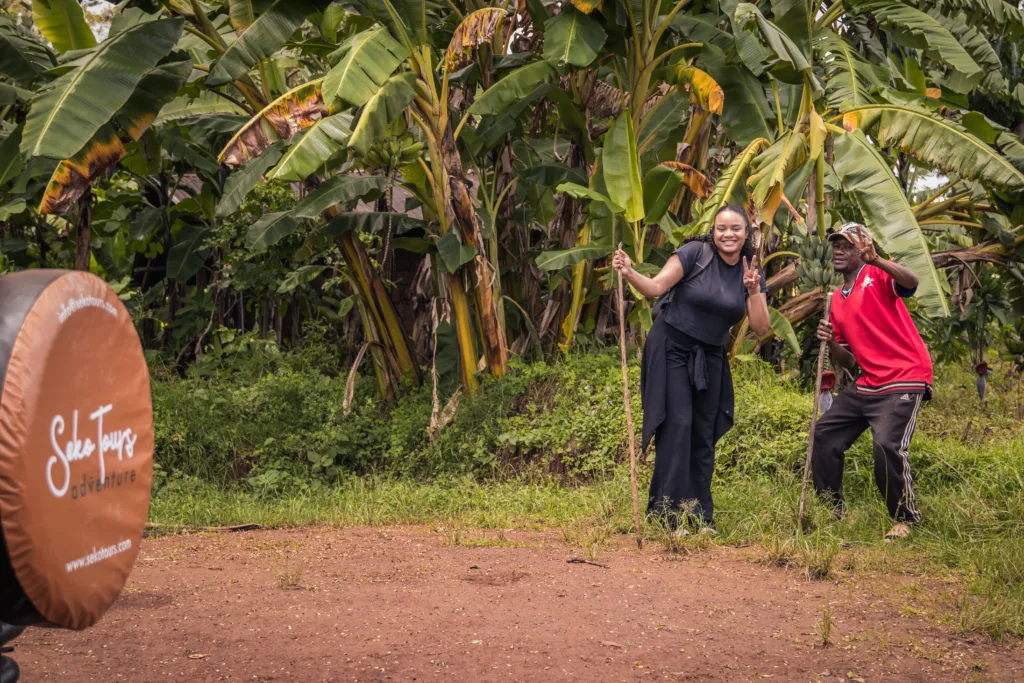
Knowing the best time to visit Materuni will help you plan a smoother hike, better views, and more comfortable conditions for swimming, exploring, and sipping coffee in the sun.
The best time to visit Materuni Waterfall is during the dry seasons: January to mid-March and June to October. Trails are easier, views are clearer, and tours run more consistently.
🌦️ Month-by-Month Breakdown
| Season | Months | Conditions |
|---|---|---|
| Short Dry Season | Jan – mid-March | Warm, mostly sunny, great for hiking and swimming |
| Long Rains | Mid-March – May | Slippery trails, lush scenery, but higher chance of rain |
| Long Dry Season | June – October | Ideal time — dry trails, cool temps, clear skies |
| Short Rains | November – December | Some rain, but still doable; vibrant landscapes |
☔ Rainy Season Pros & Cons
Pros:
- Lush, green rainforest
- Fewer tourists
- Dramatic waterfall flow
Cons:
- Muddy, slippery hiking trails
- Limited visibility (clouds may block the view)
- Harder road access to Materuni village
💡 Pro Tip: If you go in the rainy season, wear sturdy hiking boots and a waterproof jacket. A walking stick is helpful on slick sections of the trail.
🧊 Is It Too Cold to Swim?
Even in dry season, the water is glacier-fed — which means it’s always cold. That said, the sun is usually warm enough to make it refreshing. If you’re hesitant, bring a towel and watch a few people jump in first (you’ll be tempted to follow!).
✅ Key Takeaways
- Dry seasons (Jan–Mar, Jun–Oct) offer the best hiking and weather for Materuni waterfall.
- Wet seasons bring stunning greenery but slippery trails — go with a good guide and dress for rain.
- The waterfall is open year-round and rarely overcrowded — it’s still a great escape even in the shoulder seasons.
- Book your Materuni hike and coffee tour in advance during high season to avoid missing out.
